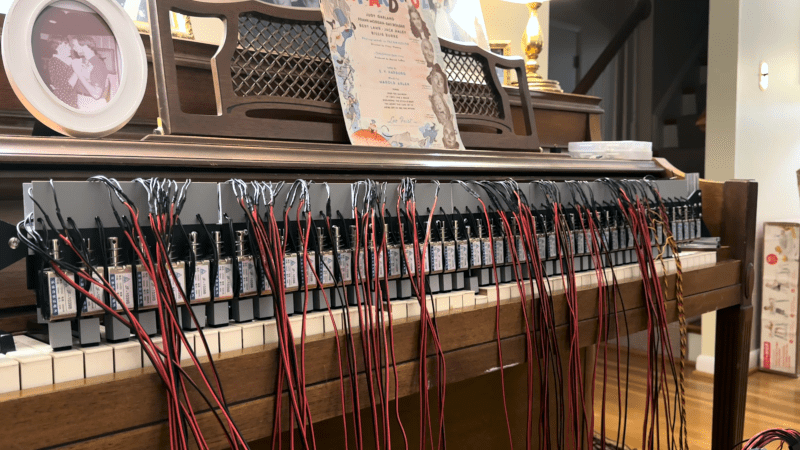[Paul] likes his piano, but he doesn’t know how to play it. The obvious answer: program an Arduino to do it. Some aluminum extrusion and solenoids later, and it was working. Well, perhaps not quite that easy — making music on a piano is more than just pushing the keys. You have to push multiple keys together and control the power behind each strike to make the music sound natural.
The project is massive since he chose to put solenoids over each key. Honestly, we might have been tempted to model ten fingers and move the solenoids around in two groups of five. True, the way it is, it can play things that would not be humanly possible, but ten solenoids, ten drivers, and two motors might have been a little easier and cheaper.
The results, however, speak for themselves. He did have one problem with the first play, though. The solenoids have a noticeable click when they actuate. The answer turned out to be orthodontic rubber bands installed on the solenoids. We aren’t sure we would have thought of that.
Player pianos, of course, are nothing new. And, yes, you can even make one with a 555. If a piano isn’t your thing, maybe try a xylophone instead.
















Can it play doom?
If you have the midi files.
“ten solenoids, ten drivers, and two motors might have been a little easier and cheaper”
No, you need ten motors to move each solenoid independently, like the fingers on each hand – but no finger play piano like a solenoid !
Yeah, that was a pretty obvious mistake. Not sure what Al Williams was thinking.
But your hand can’t span an infinite number of keys. So, sure you might have to allow some travel on the solenoids (but, keep in mind, I can make any “shape” of finger presses with the solenoids) or I could make each “hand” have, for example, 8 or 9 solenoids so I can strike all the keys a human hand can without moving anything). I still would bet that if you don’t care that the you strike with the “wrong” finger, you could still play nearly anything meant for humans to play that the original design could play. The question would be, would it be easier to move 5 slightly to account for the hand spread or just add more solenoids.
Moving hands would be very tough I think, especially when some pieces require you to swap over your hands, would mean a lot of ‘hand motion’ in addition to aligning with the keys after motion – without making noise. Also you might need to move the hand between two very short notes purely based on the range of solenoids…. Wouldnt want to write the software, or deal with the heavy ‘hand weights’ being thrown from side to side.
Excellent Job, this is needed in homes / Churches, and many other venues. Piano is one of the greatest
Instruments when it comes to music. This invention is not only a money making invention,
It is also a soul winning invention.
Piano companies, and music scoring software companies are now jumping for joy for this invention. Remember to pay your Tithes and offerings God has bless you with this invention.
If he used the smaller solenoid it might have been enough to lift the whippens directly and return with gravity instead of springs. It would fit inside and leave the piano playable. I’ve installed many of the electric players and have 2 or more sets of older solenoids where they upgraded to the newest driver system. The best are trained to play each note as soft as possible and then map that to midi note level 0. Their custom software uses 1024 levels internal to the 128 of midi.
Ah, the lovely clack of solenoids… with some piano in the background.
Until someone invents a silent solenoid, this is not the way to put an instrument under software control.
i guess you didnt watch the part of the video (and hear the result) where this is solved for.
I think this a wonderful project.
That said, my ear detect a lag in some of the more rapid note sequences. I wonder if this is an artifact of latency in the code or possibly the mechanical time constants of the solenoid, spring, and key.
Yes I noticed that, would love to see that ironed out and then a really tough piece of music played on it
Yes I think I heard that too. Would love to see the problem solved and then see the piano play a really complex piece of music.
Great project
In the second piece? It seems to be a poor arrangement, in the right hand triple notes.
Buy a Roland Synthesizer. Connect the Synth to MIDI and audio amp. Seclect Piano patch. Press Play.
Done.
Roland? Yamaha would like to have a word with you.
Goodness gracious, get an older player piano and update it from the back side so the instrument can still be usefully played.
Theirs is a fantastic musical instrument museum in downtown Brussels that has a version of this built in the early 20th century based on old paper roll player piano technology. The entire assembly looked like small dresser and could be rolled in front of the keyboard of any piano. There was a small actuator for every key. The museum also features many other curiosities any music maker would delight in !